- Market services
-
Compliance audits & reviews
Our audit team undertakes the complete range of audits required of Australian accounting laws to help you to help you meet obligations or fulfil best practice procedures.
-
Audit quality
We are fiercely dedicated to quality, use proven and globally tested audit methodologies, and invest in technology and innovation.
-
Financial reporting advisory
Our financial reporting advisory team helps you understand changes in accounting standards, develop strategies and communicate with your stakeholders.
-
Audit advisory
Grant Thornton’s audit advisory team works alongside our clients, providing a full range of reviews and audits required of your business.
-
Digital assurance
We capture actionable, quality insights from data within your financial reporting and auditing processes.

-
Corporate tax & advisory
We provide comprehensive corporate tax and advisory service across the full spectrum of the corporate tax process.
-
Private business tax & advisory
We work with private businesses and their leaders on all their business tax and advisory needs.
-
Tax compliance
We work alongside clients to manage all tax compliance needs and identify potential compliance or tax risk issues.
-
Employment tax
We help clients understand and address their employment tax obligations to ensure compliance and optimal tax positioning for their business and employees.
-
International tax
We understand what it means to manage tax issues across multiple jurisdictions, and create effective strategies to address complex challenges.
-
GST, stamp duty & indirect tax
Our deep technical knowledge and practical experience means we can help you manage and minimise the impact of GST and indirect tax, like stamp duty.
-
Tax law
Our team – which includes tax lawyers – helps you understand and implement regulatory requirements for your business.
-
Innovation Incentives
Our national team has extensive experience navigating all aspects of the government grants and research and development tax incentives.
-
Transfer pricing
Transfer pricing is one of the most challenging tax issues. We help clients with all their transfer pricing requirements.
-
Tax digital consulting
We analyse high-volume and unstructured data from multiple sources from our clients to give them actionable insights for complex business problems.
-
Corporate simplification
We provide corporate simplification and managed wind-down advice to help streamline and further improve your business.
-
Superannuation and SMSF
Increasingly, Australians are seeing the benefits, advantages and flexibility of taking control of their own superannuation and retirement planning.

-
Payroll consulting & Award compliance
Many organisations are grappling with a myriad of employee agreements and obligations, resulting in a wide variety of payments to their people.
-
Cyber resilience
The spectrum of cyber risks and threats is now so significant that simply addressing cybersecurity on its own isn’t enough.
-
Internal audit
We provide independent oversight and review of your organisation's control environments to manage key risks, inform good decision-making and improve performance.
-
Financial crime
Our team helps clients navigate and meet their obligations to mitigate crime as well as develop and implement their risk management strategies.
-
Consumer Data Right
Consumer Data Right (CDR) aims to provide Australians with more control over how their data is used and disclosed.
-
Risk management
We enable our clients to achieve their strategic objectives, fulfil their purpose and live their values supported by effective and appropriate risk management.
-
Controls assurance
In Australia, as with other developed economies, regulatory and market expectations regarding corporate transparency continue to increase.
-
Governance
Through fit for purpose governance we enable our clients to make the appropriate decisions on a timely basis.
-
Regulatory compliance
We enable our clients to navigate and meet their regulatory and compliance obligations.

-
Forensic accounting and dispute advisory
Our team advises at all stages of a litigation dispute, taking an independent view while gathering and reviewing evidence and contributing to expert reports.
-
Investigations
Our licensed forensic investigators with domestic and international experience deliver high quality results in the jurisdictions in which you operate.
-
Asset tracing investigations
Our team of specialist forensic accountants and investigators have extensive experience in tracing assets and the flow of funds.

-
Mergers and acquisitions
Our mergers and acquisitions specialists guide you through the whole process to get the deal done and lay the groundwork for long-term success.
-
Acquisition search & strategy
We help clients identify, finance, perform due diligence and execute acquisitions to maximise the growth opportunities of your business.
-
Selling a business
Our M&A team works with clients to achieve a full or partial sale of their business, to ensure achievement of strategic ambitions and optimal outcomes for stakeholders.
-
Operational deal services
Our operational deal services team helps to ensure the greatest possible outcome and value is gained through post merger integration or post acquisition integration.
-
Transaction advisory
Our transaction advisory services support our clients to make informed investment decisions through robust financial due diligence.
-
ESG Due Diligence
Our ESG due diligence process evaluates a company's environmental, social, and governance factors during the pre-investment phase to determine the overall maturity of the entity, manage potential risks, and identify opportunities.
-
Business valuations
We use our expertise and unique and in-depth methodology to undertake business valuations to help clients meet strategic goals.
-
Tax in mergers & acquisition
We provide expert advice for all M&A taxation aspects to ensure you meet all obligations and are optimally positioned.

-
Corporate finance
We provide effective and strategic corporate finance services across all stages of investments and transactions so clients can better manage costs and maximise returns.
-
Debt advisory
We work closely with clients and lenders to provide holistic debt advisory services so you can raise or manage existing debt to meet your strategic goals.
-
Working capital optimisation
Our proven methodology identifies opportunities to improve your processes and optimise working capital, and we work with to implement changes and monitor their effectiveness.
-
Capital markets
Our team has significant experience in capital markets and helps across every phase of the IPO process.
-
Debt and project finance raising
Backed by our experience accessing full range of available funding types, we work with clients to develop and implement capital raising strategies.
-
Private equity
We provide advice in accessing private equity capital.
-
Financial modelling
Our financial modelling advisory team provides strategic, economic, financial and valuation advice for project types and sizes.
-
Payments advisory
We provide merchants-focused payments advice on all aspects of payment processes and technologies.

-
Voluntary administration & DOCA
We help businesses considering or in voluntary administration to achieve best possible outcomes.
-
Corporate insolvency & liquidation
We help clients facing corporate insolvency to undertake the liquidation process to achieve a fair and orderly company wind up.
-
Complex and international insolvency
As corporate finance specialists, Grant Thornton can help you with raising equity, listings, corporate structuring and compliance.
-
Safe Harbour advisory
Our Safe Harbour Advisory helps directors address requirements for Safe Harbour protection and business turnaround.
-
Bankruptcy and personal insolvency
We help clients make informed choices around bankruptcy and personal insolvency to ensure the best personal and stakeholder outcome.
-
Creditor advisory services
Our credit advisory services team works provides clients with credit management assistance and credit advice to recapture otherwise lost value.
-
Small business restructuring process
We provide expert advice and guidance for businesses that may need to enter or are currently in small business restructuring process.
-
Asset tracing investigations
Our team of specialist forensic accountants and investigators have extensive experience in tracing assets and the flow of funds.

-
Independent business reviews
Does your company need a health check? Grant Thornton’s expert team can help you get to the heart of your issues to drive sustainable growth.
-
Commercial performance
We help clients improve commercial performance, profitability and address challenges after internal or external triggers require a major business model shift.
-
Safe Harbour advisory
Our Safe Harbour advisory helps directors address requirements for Safe Harbour protection and business turnaround.
-
Corporate simplification
We provide corporate simplification and managed wind-down advice to help streamline and further improve your business.
-
Director advisory services
We provide strategic director advisory services in times of business distress to help directors navigate issues and protect their company and themselves from liability.
-
Debt advisory
We work closely with clients and lenders to provide holistic debt advisory services so you can raise or manage existing debt to meet your strategic goals.

-
Business planning & strategy
Our clients can access business planning and strategy advice through our value add business strategy sessions.
-
Private business company secretarial services
We provide company secretarial services and expert advice for private businesses on all company secretarial matters.
-
Outsourced accounting services
We act as a third-party partner to international businesses looking to invest in Australia on your day-to-day finance and accounting needs.
-
Superannuation and SMSF
We provide SMSF advisory services across all aspects of superannuation and associated tax laws to help you protect and grow your wealth.
-
Management reporting
We help you build comprehensive management reporting so that you have key insights as your business grows and changes.
-
Financial reporting
We help with all financial reporting needs, including set up, scaling up, spotting issues and improving efficiency.
-
Forecasting & budgeting
We help you build and maintain a business forecasting and budgeting model for ongoing insights about your business.
-
ATO audit support
Our team of experts provide ATO audit support across the whole process to ensure ATO requirements are met.
-
Family business consulting
Our family business consulting team works with family businesses on running their businesses for continued future success.
-
Private business taxation and structuring
We help private business leaders efficiently structure their organisation for optimal operation and tax compliance.
-
Outsourced CFO services
Our outsourced CFO services provide a full suite of CFO, tax and finance services and advice to help clients manage risk, optimise operations and grow.
-
ESG, sustainability and climate reporting
There is a growing demand for organisations to provide transparency on their commitment to sustainability and disclosure of the nonfinancial impacts of their business activities. Commonly, the responsibility for sustainability and ESG reporting is landing with CFOs and finance teams, requiring a reassessment of a range of reporting processes and controls.
-
ESG, sustainability and climate advisory
With the ESG and sustainability landscape continuing to evolve, we are focussed on helping your business to understand what ESG and sustainability represents and the opportunities and challenges it can provide.
-
ESG, sustainability and climate reporting assurance
As the demand for organisations to prepare information in relation to ESG & sustainability continues to increase, through changes in regulatory requirements or stakeholder expectations, there is a growing need for assurance over the information prepared.
-
ESG and sustainability due diligence
As environmental, social, and governance (ESG) considerations become increasingly pivotal for dealmakers in Australia, it is important for investors to feel confident in assessing transactions through an ESG lens.

-
Management consulting
Our management consulting services team helps you to plan and implement the right strategy to deliver sustainable growth.
-
Financial consulting
We provide financial consulting services to keep your business running so you focus on your clients and reaching strategic goals.

-
China practice
The investment opportunities between Australia and China are well established yet, in recent years, have also diversified.
-
Japan practice
The trading partnership between Japan and Australia is long-standing and increasingly important to both countries’ economies.
-
India practice
It’s an exciting time for Indian and Australian businesses looking to each jurisdiction as part of their growth ambitions.
-
Singapore practice
Our Singapore Practice works alongside Singaporean companies to achieve growth through investment and market expansion into Australia.
-
Vietnam practice
Investment and business opportunities in Vietnam are expanding rapidly, driven by new markets, diverse industries, and Vietnam's growing role in export manufacturing, foreign investment, and strong domestic demand.

-
 Client Alert Wine not? Primary production land tax exemption no longer on the vineFor wine producers and vineyard owners, the recent New South Wales Civil and Administrative Tribunal decision in Zonadi Holdings Pty Ltd ATF Wombat Investment Trust v Chief Commissioner of State Revenue [2025] NSWCATAD 84 may spell trouble for their current primary production land tax exemptions.
Client Alert Wine not? Primary production land tax exemption no longer on the vineFor wine producers and vineyard owners, the recent New South Wales Civil and Administrative Tribunal decision in Zonadi Holdings Pty Ltd ATF Wombat Investment Trust v Chief Commissioner of State Revenue [2025] NSWCATAD 84 may spell trouble for their current primary production land tax exemptions. -
 Client Alert Unlock 2025: government grants updateIf government grants are part of your 2025 strategy, take note of the available quarter one funding opportunities. With increasing inflationary pressures, government grants can be an essential alternative funding source for businesses with critical investment projects.
Client Alert Unlock 2025: government grants updateIf government grants are part of your 2025 strategy, take note of the available quarter one funding opportunities. With increasing inflationary pressures, government grants can be an essential alternative funding source for businesses with critical investment projects. -
 Report Agribusiness, Food & Beverage Dealtracker 2024Merger & Acquisition (M&A) and equity market activity in the Agribusiness, Food & Beverage (Ag, F&B) sector is undergoing a strategic shift, as investors have become more selective and increasingly cautious in response to global economic uncertainty.
Report Agribusiness, Food & Beverage Dealtracker 2024Merger & Acquisition (M&A) and equity market activity in the Agribusiness, Food & Beverage (Ag, F&B) sector is undergoing a strategic shift, as investors have become more selective and increasingly cautious in response to global economic uncertainty. -
 Client Alert Government Grants in FY25As we embark on a new financial year, it’s crucial to take a strategic approach to understanding the government grants landscape.
Client Alert Government Grants in FY25As we embark on a new financial year, it’s crucial to take a strategic approach to understanding the government grants landscape.
-
Renewable Energy
Transformation through energy transition

-
Flexibility & benefits
The compelling client experience we’re passionate about creating at Grant Thornton can only be achieved through our people. We’ll encourage you to influence how, when and where you work, and take control of your time.
-
Your career development
At Grant Thornton, we strive to create a culture of continuous learning and growth. Throughout every stage of your career, you’ll to be encouraged and supported to seize opportunities and reach your full potential.
-
Diversity & inclusion
To be able to reach your remarkable, we understand that you need to feel connected and respected as your authentic self – so we listen and strive for deeper understanding of what belonging means.
-
In the community
We’re passionate about making a difference in our communities. Through our sustainability and community engagement initiatives, we aim to contribute to society by creating lasting benefits that empower others to thrive.
-
Graduate opportunities
As a new graduate, we aim to provide you more than just your ‘traditional’ graduate program; instead we kick start your career as an Associate and support you to turn theory into practice.
-
Vacation program
Our vacation experience program will give you the opportunity to begin your career well before you finish your degree.
-
The application process
Applying is simple! Find out more about each stage of the recruitment process here.
-
FAQs
Got questions about applying? Explore frequently asked questions about our early careers programs.
-
Our services lines
Learn about our services at Grant Thornton
-
Current opportunities
Current opportunities
-
Remarkable people
Our team members share their remarkable career journeys and experiences of working at Grant Thornton.
-
Working at Grant Thornton
Explore our culture, benefits and ways we support you in your career.
-
Current opportunities
Positions available.
-
Contact us
Get in touch

In the eighteen months since COVID-19 first presented in Australia, it’s fair to say that the initial chorus of gloomy predictions for real estate and construction didn’t come to pass, and thankfully have proven to be well off the mark.
While this shift in industry sentiment appears on face value to be a great outcome, the speed and extent to which it has taken place presents a significant risk to many builders over the coming year as the cost of inputs rise.
What is the extent of the cost escalation since the boom emerged, and can we expect this trend to normalise anytime soon?
The Australian Bureau of Statistics’ (ABS) June 2021 figures demonstrate the extent of inflation for Australian detached residential build costs, with input costs up by almost 8% since commencement of the pandemic in early 2020. The graph below indicates price stability prior to the pandemic, followed by an accelerating inflationary trend from the start of 2021.
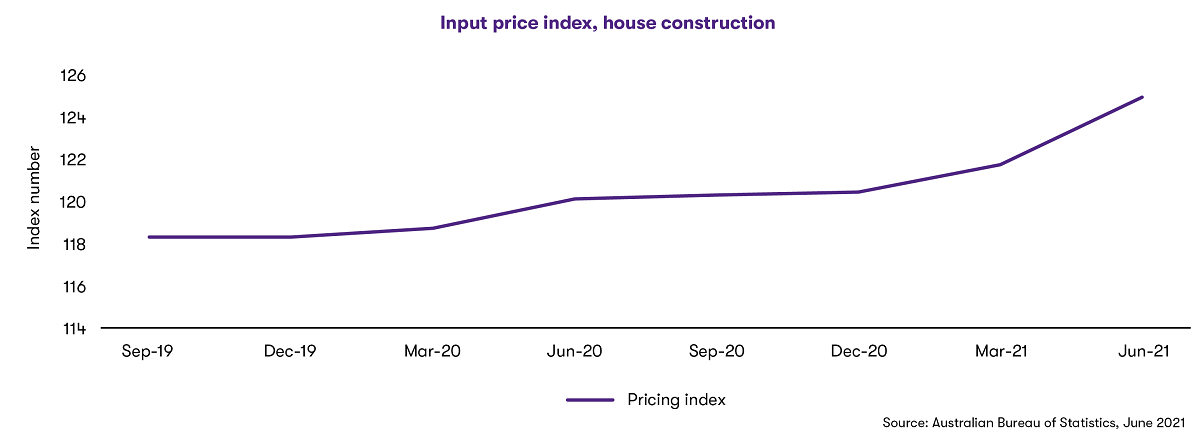
The boom few predicted
In May 2020 Australia’s largest residential property lender, CBA, predicted a drop in property prices of up to 32% over the coming years, and mass unemployment. This sentiment was generally shared by most economists, notwithstanding the massive economic stimulus packages already being rolled out by governments and the fact that most states were already moving through the first stages of easing of social distancing restrictions.
Less than 12 months later, the ABS reported that private sector house deliveries rose 5.9% to a 20 year high of 35,869 in the March 21 quarter, on the back of a rise of 27.1% in the December quarter.
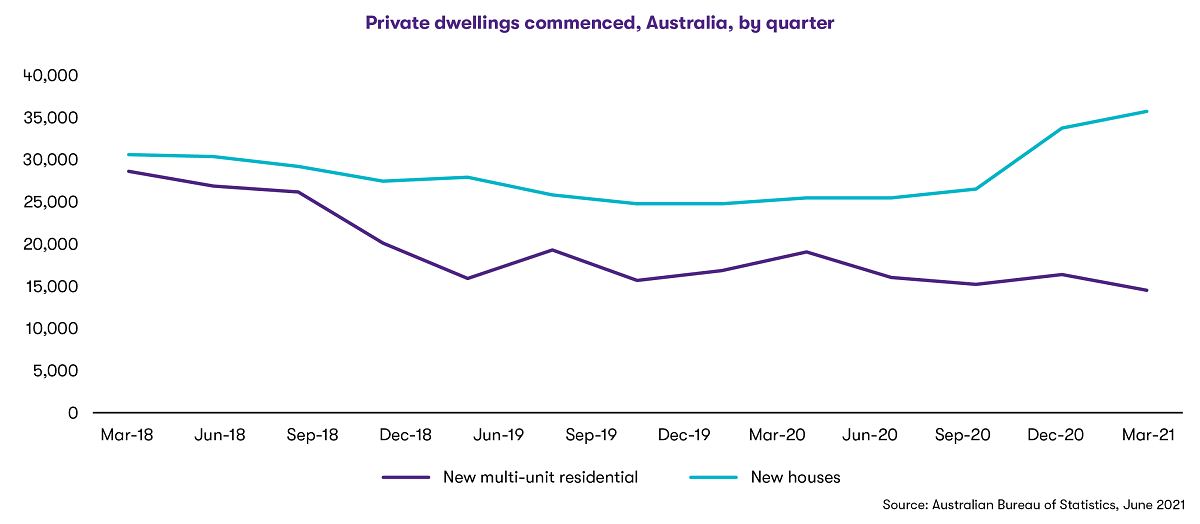
The housing boom appears to be concentrated in detached dwellings, with a record 143,700 detached homes commencing construction across the country, driven by a combination of first home buyers cashing in on Homebuilder, regional relocations of remote working professionals, and a general rush to domestic outdoor living space over the confines of urban unit living. Denser housing options haven’t fared as well, yet the surge in demand for housing is very much a whole of first-world phenomenon, contributing to rapid inflation in global material costs as supply chain limitations combine with surging demand driven by big government stimulus packages in the bigger economies. The Australian Government’s stimulus measures around housing and infrastructure, are dwarfed by the $1 trillion infrastructure package recently passed the United States Senate.
Material price risk proving a difficult challenge for builders
The June 2021 figures from the ABS evidence the rising costs for detached residential builds in Australia, dominated by timber, steel and electrical.
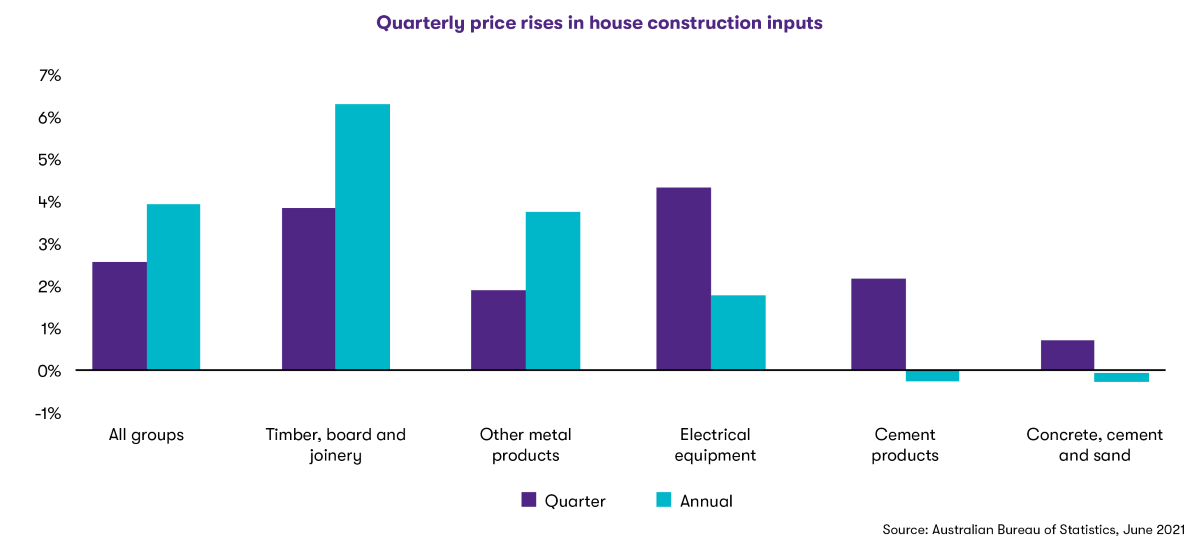
Timber the biggest issue
Master Builders Queensland deputy chief executive Paul Bidwell was recently interviewed on the issue and considers timber is “by far and away the biggest issue”, with timber frames, laminated beams and roof trusses in short supply and prices “up 70 per cent since last November and still rising”.
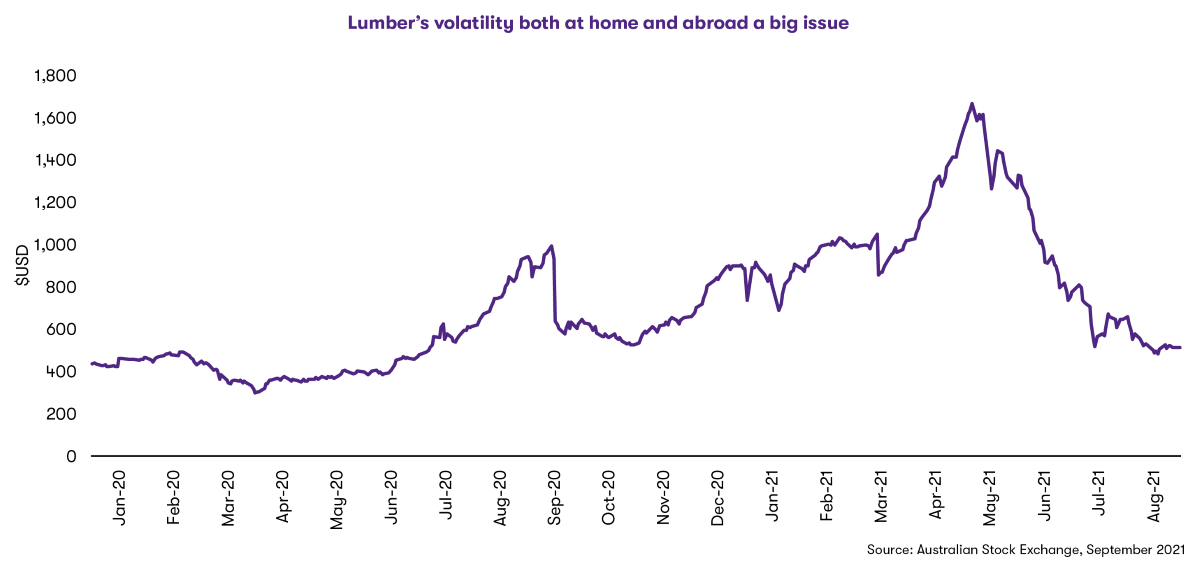
The price of lumber reached historic levels in May this year, peaking at US$1600 per 1000 board feet, a 300 per cent rise on the previous year. While the spike in international lumber prices has unravelled in recent months, it does not necessarily reflect the Australian realities of timber demand which is supplied almost 85% from domestic production. Traditionally, Australia imported about 20% of its house frame timber but this has shrunk due to disruptions to shipping and the spike in construction activity in the more lucrative US and Europe markets.
While local producers are operating at capacity, the limits of domestic production have meant cost increases and higher demand for imported timber. Framing timber is particularly in-demand, increasing 25% in price over 12 months, 9.2% in the June 2021 quarter, and according to analysts, may see a further rise when the September 2021 statistics are released. After that, expectations are that we will price moderation may not occur until the surge of HomeBuilder homes are completed.
Price of Steel – Up, Up and Away
While there is much discussion around the merits of substituting steel for timber, it may be challenging for builders to make the switch when already locked into pricing and regulations or approvals needing to keep pace with any changes.
The graph below demonstrates the rapid rise in Chinese steel prices over the last nine months as global economies rebounded from 2020 slumps.
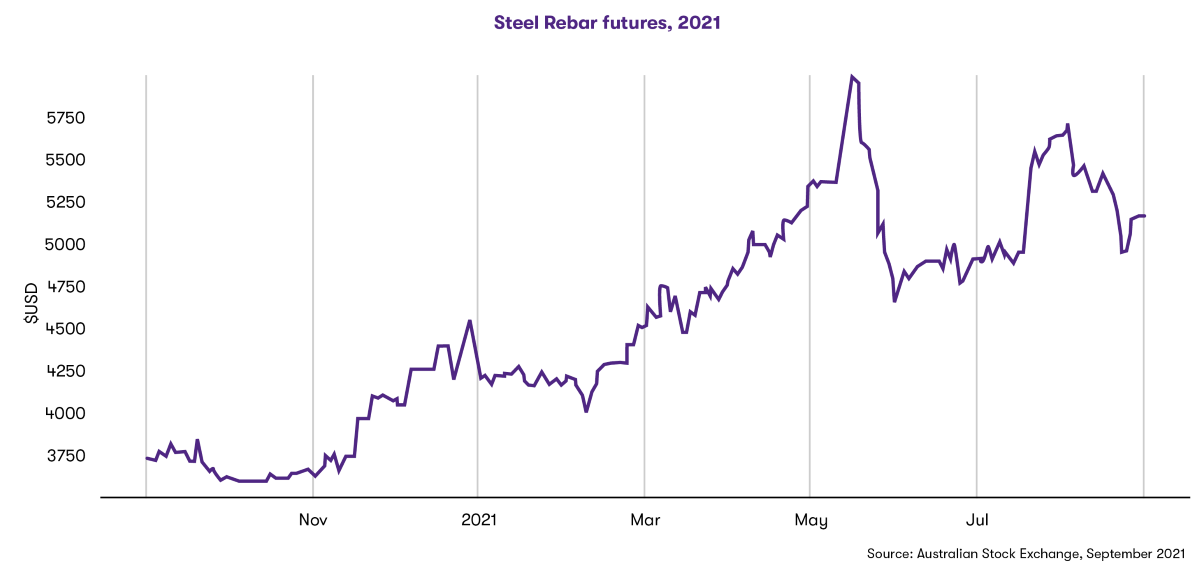
Rebar prices remain 35% higher than 12 months ago and are expected to remain generally elevated supported by continuing government stimulus packages and efforts by the Chinese Government to curb carbon emissions. Not good news for constructions heavily reliant on steel and concrete.
Labour market forces
The absence of international immigration for the last 18 months has resulted in significant shortages, particularly for blue collar workers. Following the initial pessimism of the early pandemic, job vacancies, measured by online job postings, have skyrocketed for construction industries in all states, particularly in those states less impacted by lockdowns.
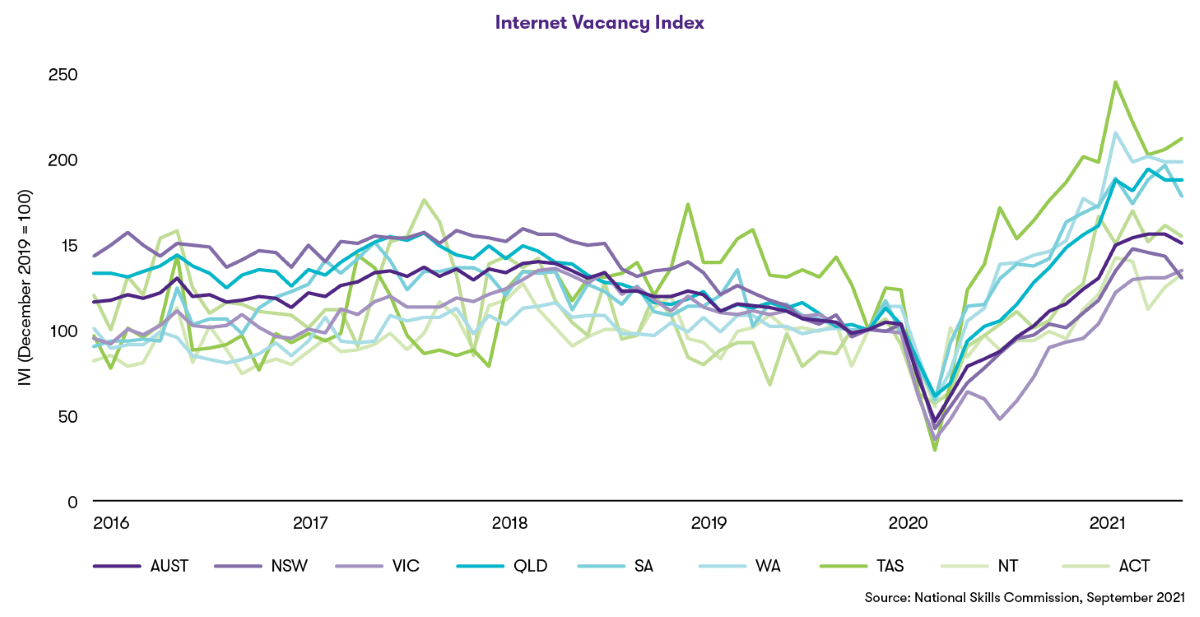
This has resulted in a significant spike in wage costs following the dip in the June quarter of 2020. Anecdotal feedback is that strong market conditions have seen workers comfortable with contract work while hourly and daily rates are high, and salaries for placements this year are up 12% on 2020 and 10% higher than 2019.
This confidence may moderate in some markets as the Delta strain has forced tighter working restrictions than were experienced in 2020. Though builders with a strong pipeline of work are choosing to still pay contractors to ensure they have access to them after government restrictions lift.
Key parties at risk
The extent of labour and material price inflation experienced by builders varies between operators. Larger operators may be cushioned by purchasing power, forward orders/ hedging instruments and attractive career opportunities. On the other hand, smaller operators may be more exposed due to less material purchasing power, limited human and financial resources to retain employees and their contractors lured to more lucrative projects.
This is reflected in anecdotal feedback from industry professionals which cite cost increases for larger industry players at 10%, whereas the exposure for a smaller residential builder may be closer to 20% rises.
Those builders who tendered aggressively to secure pipeline revenue during CY2020 and early 2021 (prior to the significant inflation manifesting) are most at risk of incurring significant losses having to deliver these projects in the current cycle. Those that entered the pandemic with a strong balance sheet and a pipeline of existing profitable projects should be able to weather the storm in most cases -particularly if JobKeeper subsidies were obtained.
By comparison, marginal operators seduced by the prospects of rapid turnover growth presented by stimulatory programs such as Homebuilder, may soon realise that their financial resources are insufficient to fund either the top-line growth, or the unexpected bottom line losses from projects now subject to the inflationary price hikes.
Recommendations
While the obvious answer to protecting builders from inflation pressures is to avoid lump sum contracts, in the building sector, lump sum contracts are more often than not the norm demanded by principals and financiers.
Mitigating damage on existing commitments
The impact of material and labour price inflation over the last six months is likely to render many committed project works unprofitable for builders. While the extent of further inflation is unknown, very few analysts and commentators are suggesting a ‘snap back’ to pre-COVID norms is likely within the next 12 months. A strategy of delaying commencement on burdensome projects may exacerbate the problem while also exposing the builder to the risk of future litigation and/or sanctions by regulators.
Accepting that inflation may be sustained is the first step, followed by quantifying the likely financial impact on affected projects and conduct modelling to ascertain when the burden of fulfilling these contractual obligations will be borne and understanding the tipping point. From this analysis, strategies may be deployed to:
- Undertake negotiations with principals to vary contract terms (real estate values have grown significantly over the last 12 months)
- Advance order materials in short supply
- Engage with financiers to ensure continuity of existing facilities critical to future operations (eg bank guarantees and equipment finance)
- Maintain liquidity (including securing fresh debt or equity funding before its needed), and
- Ensure the business remains compliant with regulatory covenants (such as the Queensland Building & Construction Commission’s (QBCC) Minimum Financial Reporting regulations or the Federal Government Pre-Qualified Contractors regime).
Ensuring the business is protected on new projects
- Ensure all new works are quoted with a sufficient buffer for future inflation/ delays
- Shorten expiration dates on quotations
- Nominate at-risk materials be subject to cost-escalation clause
- Further protective measures in contracts (Extensions of time, contingent start date based on availability of materials)
How can we help?
The team at Grant Thornton Australia can offer expertise to assist builders, developers, financiers or other key stakeholders navigate distress:
- Quantifying the financial impact of these market factors on business cash flow
- Connecting data provided by quality surveyors to create dynamic cash flow forecasts, specified to contract terms and the pipeline of specific businesses
- Assisting in securing finance to improve working capital, via debtor financiers, alternate debt or extension of existing bank facilities
- Assisting in negotiations with key counterparties, such as the ATO, contract principals or sub-contractors, and
- Managing regulatory compliance with bodies like the QBCC or State Government pre-qualifications.
While the price volatility and tightened resources risk presents a major challenge for builders, developers and financiers alike, the exploding lead times and delays of materials contribute to further headaches. It will be vital to map out the potential impact on your projects, so you can act in time and preserve the longer term sustainability of your business.
Supply chain risk management in the COVID building boom
Watch this webinar on-demand as we host a panel discussion on the ways businesses are responding to supply chain challenges and when supply/demand may return to normal – if at all.

























